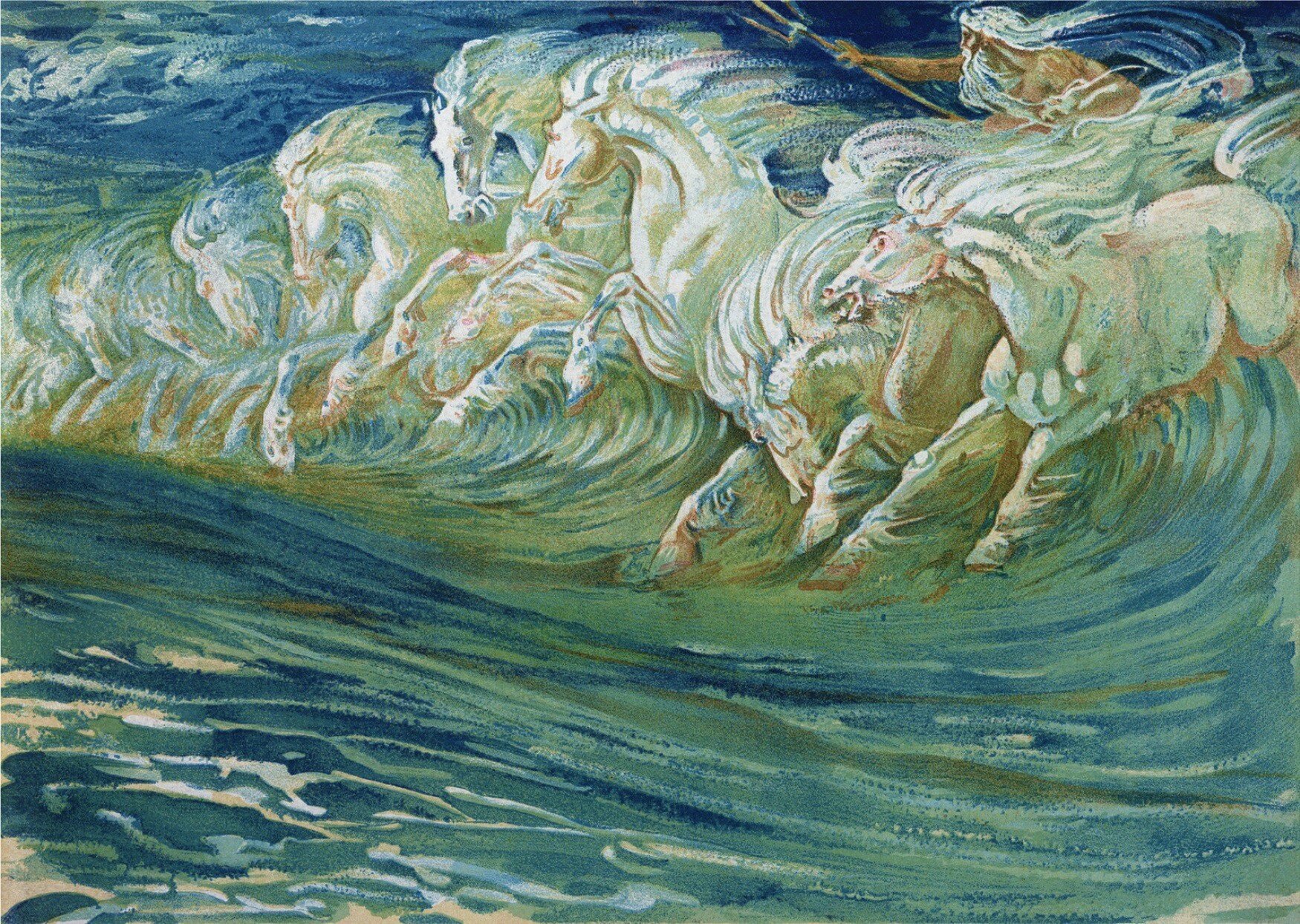Astrology and climate change
Generated with Midjourney
Astrology and climate change
MARCH 9, 2021We can no longer look away. We are in the midst of a crisis. Temperatures and sea levels are rising, glaciers are retreating, oceans are heating, and natural disasters are becoming more frequent, all as a direct result of human activity. In other words: humanity is committing ecocide. While many still prefer to turn a blind eye, global warming remains the greatest threat to human security. In response, I will explore the correlation between astrology and climate change, assuming what is happening on earth is mirrored by the cosmos, and look the problem in the eye.
Slow moving planets
To understand the astrological correlations with climate change, we need to look at the slow-moving planets: Uranus, Neptune, and Pluto. These outer planets move much more slowly through the zodiac than the inner planets like Mercury, Venus, and Mars, due to their greater distance from the Sun. Their slower orbits mean they spend years, sometimes decades, in a single sign, shaping long-term societal and environmental patterns.
Uranus is the planet of disruption, innovation, and sudden change. Its influence is often linked to unexpected events, accidents, and upheavals, both natural and societal. Astrologically, it’s associated with electricity, rebellion, and instability. Earthquakes and thunderstorms also fall under Uranus’s domain. Uranus takes approximately 84 years to complete one orbit around the Sun and spends about 7 years in each zodiac sign.
Neptune governs the ocean and everything fluid. In Roman mythology, Neptune was the god of the sea and storms. His equivalent in Greek mythology is the god Poseidon. Beyond water, Neptune represents the dissolving of boundaries, illusions, and collective dreams or delusions. Its energy can blur reality or inspire deep compassion and spirituality. Neptune orbits the Sun once every 165 years, remaining in each sign for roughly 14 years.
Pluto, the furthest and slowest of the three, symbolizes power, destruction, transformation, and rebirth. Its influence is intense and often associated with deep psychological change, societal collapse, and regeneration. Though small in size, Pluto's astrological power is profound. It completes an orbit around the Sun every 248 years, staying in each sign for about 12 to 30 years, depending on its position in the elliptical orbit.
Neptune's Horses by Walter Crane (1910)
The sign of Pisces
The slow-moving planets, Uranus, Neptune and Pluto, have long influenced global social, cultural, political, economic, and environmental developments. In this century, these outer planets are transitioning through the sign of Pisces in relatively quick succession, highlighting the growing astrological significance of this sign during our time. Pisces, a water sign symbolized by two fish swimming in opposite directions, represents fluidity, dissolution, spirituality, sacrifice and escapism. Its modern ruler is Neptune, the planet that reigns the ocean.
✷ Uranus moved through Pisces from 2003 to 2011. Its previous transit occurred between 1919 and 1928.
✷ Neptune has been in Pisces since 2011 and will remain there until 2026. Its last visit spanned 1847 to 1862.
✷ Pluto will enter Pisces in 2043, staying until 2067. The last time Pluto was in Pisces was from 1797 to 1823.
These overlapping transits suggest a century deeply influenced by Piscean themes: rising sea levels, increasing floods, dissolving boundaries, the emergence of climate refugees, and patterns of sacrifice, martyrdom, collective escapism, and emotional reckoning. When slow-moving planets pass through the watery sign of Pisces, we can expect profound shifts in humanity’s relationship with the oceans, the rivers, the climate, and the collective psyche.
While it’s difficult to link past planetary transits in Pisces with historical floods or climate-related events due to gaps or underreporting in older data, more recent records tell a clearer story. Since Uranus entered Pisces in the early 2000s, the number of recorded floods and water-related disasters has risen significantly. Although this is partly due to improved access to information and reporting, the trend itself is unmistakable.
Uranus in Pisces
Uranus began its transit through Pisces with a dramatic and tragic event: the Indian Ocean earthquake and tsunami in 2004. One of the most significant floods during this transit occurred in March 2010, when record rainfall led to the Queensland floods in Australia. At that time, a powerful Pisces stellium, a cluster of planets including the Sun, Moon, Mercury, Jupiter, and Uranus, formed in the final degrees of Pisces. This stellium stood in opposition to Saturn in the early degrees of Libra, highlighting a moment of extreme tension and imbalance. Uranus has since moved on from Pisces.
Neptune in Pisces
Neptune entered Pisces in 2011 and made its presence known early on with Hurricane Sandy in 2012, a devastating storm that impacted the eastern United States. In February 2013, Neptune formed a powerful conjunction with Mercury, Mars, and Chiron, all in Pisces, while simultaneously squaring Jupiter in Gemini. This period coincided with Winter Storm Nemo, a massive blizzard that swept across North America. These events reflect the emotional intensity, boundary-dissolving nature, and watery symbolism associated with Neptune in Pisces. In recent years, the list of examples has grown considerably.
Based on current planetary alignments, I anticipate continued increases in flooding and extreme weather as long as Neptune remains in Pisces, a transit that will last until 2026. It’s unlikely Neptune will leave the sign quietly. In March 2023, Saturn will join Neptune in Pisces. Then, in January 2025, the North Node will also enter Pisces, joining both Neptune and Saturn. Throughout 2025, both Saturn and the North Node will form conjunctions with Neptune, intensifying this energetic focus.
“An aerial view shows damage caused by floods following torrential rain in Kumamura, Japan” by Kim Kyung-Hoon via Reuters (2020)
Pluto in Aquarius: climate action
There’s reason to believe that we may begin to regain some control over the effects of climate change after 2026, when Neptune exits Pisces. This shift could signal a period of greater environmental stability, possibly the result of large-scale climate action and technological innovation.
At present, both Jupiter and Saturn can be found in Aquarius, and Pluto will enter Aquarius in 2023, marking the beginning of a new era. Aquarius is a sign associated with activism, innovation, community, and systemic awareness. It understands how societal structures operate and seeks to reform them, often through progressive thinking and technological solutions.
With Pluto, the planet of transformation and power, in Aquarius, we are likely to see a deeper collective awakening around what needs to change and how to do it. Pluto in Aquarius brings the potential for a clearer, broader vision of how to build systems that serve both humanity and the Earth. It supports the dismantling of outdated institutions and the emergence of more sustainable, equitable models for the future.
“Thousands of youth strikers gather in Parliament Square in central London to protest the government's lack of action on climate change” by Barcroft Media via Getty Images (2019)
Toward the end of 2027 and into the beginning of 2028, the North Node in Aquarius will form a conjunction with Pluto in Aquarius, signaling a powerful moment of collective transformation and evolutionary purpose. At the same time, Pluto in Aquarius will make a harmonious trine to Uranus in Gemini: a dynamic and revolutionary combination. My predication is that around this time, we’ll begin to see tangible, innovative solutions to climate change. The world may even start to resemble the high-tech, sci-fi future we’ve only seen in films.
Adding to this momentum is the emergence of a new generation into positions of influence. Those born with Neptune in Aquarius (1998–2012) and Uranus in Aquarius (1995–2003), key members of Gen Z, will be coming of age. This is a generation deeply attuned to innovation, community, and technology. They are open-minded, visionary, and unafraid to question the status quo. They are the ones who will implement radical change, and, frankly, they might just be the ones who save us all.
Pluto in Pisces: power to the ocean
While Pluto in Aquarius (2023–2043) is likely to bring revolutions, innovation, and a sense of relief or regained control, I expect that this will be temporary. Once Pluto enters Pisces in 2043, we may no longer be able to tame the forces of nature. This transit could mark a period of irreversible transformation, particularly concerning the oceans, rivers, coastlines, and global ecosystems. Under Pluto in Pisces, the oceans and rivers hold all the power, and it may begin to redraw the boundaries of our world map. Under Pluto in Pisces, we’re also likely to see a rise in climate refugees, alongside an increase in escapism, religion, and spirituality, as people search for ways to cope with the emotional and existential impact of climate change.
The last time Pluto moved through Pisces was between 1797 and 1823. While historical data from that period is often incomplete, certain extreme events have been well documented. A striking example is the climate crisis of 1816, known as the Year Without a Summer. During that year, Pluto in Pisces formed a square with Neptune in Sagittarius, and average global temperatures dropped by 0.4–0.7°C. Europe experienced the coldest summer on record between 1766 and 2000, with widespread crop failures and famine.
Notably, Pluto and Neptune will form a square again between 2061 and 2065, this time once more with Pluto in Pisces and Neptune in Sagittarius, echoing the alignment of 1816. Given this resonance, it's highly likely that we could face another period of severe climate disruption. The signs point toward a future in which natural forces reclaim their dominance, and humanity is forced to confront its limits.
Map of the world in 2086 after a massive sea level rise via Reddit (2016)
Now what?
We must face the reality: there is no escaping the effects of climate change. But that doesn't mean we are powerless. The time to act is now, to minimize damage, build resilience, and do everything we can to protect our future. The stars are loud and clear in their warnings, but astrology is not destiny. The cosmic patterns show us where to direct our energy, our care, and even our resources. The stars incline, not determine.
Astrologer Jessica Adams puts it well in her blog Climate Crisis Astrology Predictions: “Astrology is here to motivate you to act so you can prevent worst-case scenarios from coming to pass.” So take practical steps: review your insurance, prepare an emergency kit, and support climate solutions however you can, whether through activism, innovation, community efforts, or conscious living. The stars won’t do the work for us. We have to meet the moment. The time for climate action is not tomorrow. It’s right now.
Photo by Markus Spiske via Unsplash (2019)
Recommendations
✷ The podcast episode “178: Disaster Preparedness + Astrology” at Ghost of a Podcast, hosted by astrologer Jessica Lanyadoo
✷ The letter “Het water komt” by Dutch writer Rutger Bregman






